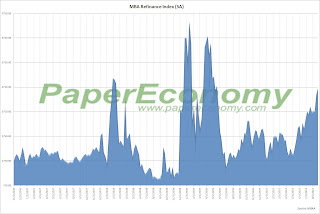Does a steep yield curve guarantee future economic growth? Usually but maybe not this time.
A recent article on BusinessInsider got me thinking about the yield curve and its power to predict when a recession is NOT likely.
The article title and copy was interesting:
Unless 'This Time It's Different', There's Now Zero Chance Of A U.S. Double Dip
Substantial research suggests that the difference between interest rates for 10-year and 3-month U.S. treasuries is a reliable leading indicator for the U.S. economy, so much so that the New York Federal Reserve even creates charts using this metric, boldly titled "Probability of a U.S. Recession".
Let's hope the science holds, since according to the New York Fed's latest chart there's almost zero chance of a U.S. recession now. In April, the treasury-spread-based probability of recession collapsed to 0.04%.
We're not going to claim we're completely sold on this metric, but have to concede that historically it has worked and it's also hard to imagine why the U.S. would fall back into recession in the near-term given the rebound already in place. Things would have to start deteriorating first, and we haven't seen that yet. Should this time be different? That's not a rhetorical question. You can read the New York Fed's justification for this metric here and decide for yourself.

Here's the chart produced by the
NY Fed as of June 21, 2010 which BusinessInsider refers to. As you can see it is saying there's effectively NO chance of a recession anytime soon.
This relationship is considered so solid the yield curve is part of the leading economic indicators published by the
Conference Board where the yield curve is 10% of the LEI index.
Even
Krugman of the NYT has commented on how a steep curve implies positive future growth.
Now, this spread could be fairly small if people expected the economy to remain in the dumps for a long time; see Japan. What the large spread now tells us is that the US economy is in the dumps now, but that investors see a reasonably good chance of a strong recovery in the not-too-distant future. That’s good news, not bad news.
Both the
Fed and
Pimco have web sections devoted to discussing the yield curve and its predictive powers.
Substantial research from the Federal Reserve on the yield curve shows it is a good predictor of future economic growth.
From Federal Reserve:
July/August 2006 - Current Issues:
Conceptual Considerations
The literature on the use of the yield curve to predict recessions has been predominantly empirical, documenting correlations rather than building theories to explain such correlations. This focus on the empirical may have created the unfortunate impression that no good explanation for the relationship exists—in other words, that the relationship is a fluke. In fact, there is no shortage of reasonable explanations, many of which date back to the early literature on this topic and have now been extended in various directions. For the most part, these explanations are mutually compatible and, viewed in their totality, suggest that the relationships between the yield curve and recessions are likely to be very robust indeed. We give two examples that emphasize monetary policy and investor expectations, respectively. . . .
Here's the important part . . .
A rise in short-term interest rates induced by monetary policy could be expected to lead to a future slowdown in real economic activity and demand for credit, putting downward pressure on future real interest rates.
So an inverted yield curve chokes lending which then slows economic growth. Conversly a steep yield curve induces lending which stimulates economic growth. Lets look at some data provided by the Federal Reserve from 1974 onward comparing yield curves and recessions. As you can see there is a strong relationship between the two. In all cases an inverted curve preceeded or coincided with recessions as shown by the gray recession bars. Furthermore no recessions occurred without a yield curve inversion (or nearly so) happening beforehand. Also note how steep the yield curve is now as compared to recent history. Rarely has the curve exceed 4%
It's no wonder the steep yield curve is considered such a reliable indicator.
Let's take it one step further and look at the relationship between a steep yield curve and economic activity through the mechanism of lending growth. This graphic adds bank loans and leases at commercial banks. Looking at the graphs you can see in each case an inverted yield curve resulted in a recession and a slowdown in lending. Once the yield curve returned to 'normal' with higher long term rates bank lending resumed growing and the country exited a recession . . .
except this time.
Bank lending continues to decline which is exceptional. (Before you get excited about what appears to be a sudden spike in the rate of lending you should know that is due to off balance sheet lending vehicles being brought back onto bank balance sheets.
Annaly's blog has the details.)

Annaly's recent blog post on debt and GDP growth reinforces the previous picture. Real credit market growth is strongly linked to real GDP growth.
My contention is the steep yield curve is no longer an accurate predictor of future economic growth due to the lack of credit growth.
Has there been another time when a steep yield curve has led us astray? Yes. Robert Shiller provides some excellent long term historical data going back to the 19th century. Let us examine some data from 1928 through World War II. While the data fields are not precisely similar they are close enough to provide analogs to modern data sets on this topic.
Here the difference between 1year and 10 year rates is shown as compared to real earnings on the Standard and Poors equity index.
While this does not show lending activity it does show what one would hope results from increased lending namely earnings growth.
Some interesting relationships can be observed:
The yield curve was very inverted in 1929 and returned to a 'normal' curve in 1930. Earnings did rebound from their lows but did not exceed their 1929 peak until after World War II.
More importantly a serious fall in earnings in 1937 coincided with a non-inverted yield curve.
The rarely mentioned mechanism (credit growth) between a steep yield curve and economic growth is not working. It is my contention until credit growth at least stops falling the steep yield curve rule of thumb should be ignored and one should be concerned with very tepid (if at all) real GDP growth.
If my thesis is correct and this rule is broken it could come to quite a shock to those who consider it dogma. Considering the yield curve is part of the Leading Economic Indicators from the Conference Board it may well be used by many in portfolio allocation decisions. If you hear in the future how the steep yield curve is showing how we can't go into a recession remember the yield curve alone does not create economic growth but creates the opportunity for increased credit growth which then causes economic growth.
This Time It's Different.
Sources:
Robert Shiller
edit 01/28/11: As has been pointed out to me in other conversations Japan has had a few recessions over the last 15-20 years while their yield curve has not been inverted.











